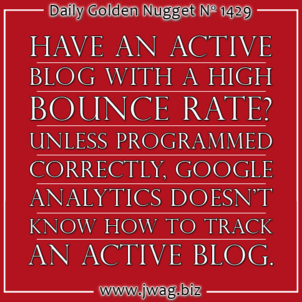
For today's #ThrowbackThursday Nugget, I'm jumping back to my explanation of bounce rate from January 2011.
Not much has changed since I wrote that previous Nugget, but I should recap the basics.
What is a Bounce Rate?
I should explain what a bounce rate is for those of you not quite up to speed. This is the percentage of people who visit your website, look at one page, click nothing else, then either close their web browser or click the browser back button. Google Analytics calculated your bounce rate for you, and you should use it to help understand if you are doing something right, or wrong, on your website.
Is Bounce Rate a Ranking Factor?
There's been a lot of controversy since I wrote the previous Nugget regarding its use as a ranking factor by Google. The first thing you need to be aware of is that Google is not using your own Analytics against you. They are not allowed to use your private information for public search results manipulation. Besides, the Google Analytics and the Google Search teams don't work together.
That said, the Google Search team has a way to measure when someone clicks on a search results and immediately clicks their browser's back button. They see this as a bounce. I've read some articles by other SEO guys who suggest that we should not call this a bounce; perhaps a "click back" is a better term.
I have to assume the bounce/click back percentage that Google Search measures is pretty close to the bounce rate that you see in Analytics, although it's probably a little lower.
It makes sense that Google would use this as a ranking metric since it clearly indicates dissatisfaction with how Google matched a search query to your website appearing in the results. Google can't tell if that dissatisfaction is the result of an ugly website or their mismatch of your site to the query phrase, they just know it wasn't a good result.
Target Bounce Rate
I'm happy to report that there's been an overall improvement in the average bounce rate that I measure within the jewelry industry. Last time I wrote about this, the average bounce rate was about 52%, as of this writing it is about 44%.
I have a feeling that the average bounce rate is dropping because the sites I'm measuring today are more modern in their functionality than the sites I was measuring 5 years ago.
Congratulations everyone! Things are starting to progress for the better, but we still need to work towards a bounce rate of about 32%. It's difficult to get lower than 32% on any website, so don't stress about it.
Contributors to High Bounce Rate
The continual website content building process has exploded since I wrote that previous Nugget. Everyone is creating different types of content now, from blogs, to infographics, to rich photos, videos, and in-depth articles. All that content helps the search engines bring people to your website.
Sadly, that content is also contributing to the higher bounce rate reported by Google Analytics, especially those blog posts!
Think about the typical blog reader for a moment. They see a social link to your blog. Click it open to a new browser tab. Spend 5 minutes reading it. Then close the browser tab. BAM! That was a bounce! Google Search does not record the bounce, but Google Analytics does.
Sadly, the websites with active blogs or other socially shared content will see a huge spike in bounce rates. I worked on one website that had an outrageous 88% bounce rate because of their blog. They didn't understand how it was that the more work they put into their blog, the higher their bounce rate grew. They almost gave up on the blogging process until I explained what their data was telling them, and how amazingly successful they were.
Fixing a High Bounce Rate
Fixing the bounce rate on an poor functioning website and fixing the bounce rate on a website with an active content building program are two completely different jobs.
The poor functioning website probably needs a usability study and a website redesign. The website with the active content building and social sharing just needs a change to their Google Analytics tracking.
The Google Analytics setup is a little tricky, and I should probably dedicate an entire Nugget to explaining it. For those of you who want to research the directions on your own, look up the GA feature called "setTimeout." This little timeout feature will allow Analytics to count the seconds someone stays on your page, and you can trigger an action once they hit 50 seconds, 80 seconds, and 185 seconds. These actions will help you record the true bounce rate of your website by showing you that people are not actually bouncing, but they are staying a while to read your blog.
Another way to fix your bounce rate is to reprogram the way your socially shared content appears on your site. Instead of allowing an entire blog post to appear you show a More or a Next button that forces the user to click. That click action creates an engagement with another page on your site, thereby lowering your bounce rate.
On a personal note, I really hate the blogging and news sites that create those More and Next buttons, slideshow style. Those same sites are usually loaded with many solicitations and JavaScripts that cause content and images to shift around. Very annoying. Don't let your web programmer set that content method for you, it's far easier to change your Google Analytics tracking codes.








